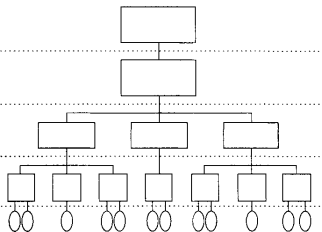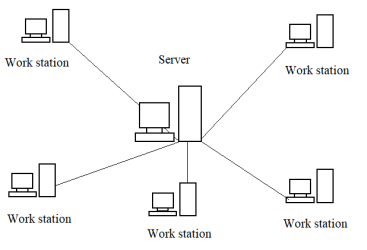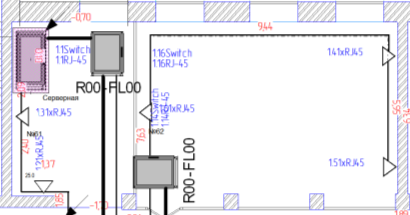This article presents the concept of a structured cabling system, as well as its implementation through an existing network. The following questions should be considered: choice of technology and structure of the cable system, topology definition, optimal way of laying fiber optic cable, selection of active and passive equipment, calculation of basic parameters and consideration of design programs.
Keywords: Structured Cabling System, network topology, switch, optical adapter, optical fiber, twisted pair, numerical aperture, damping, dispersion, bandwidth.
Данная статья дает понятие о структурированной кабельной системе, а также её реализации, посредством уже существующей сети. Рассмотрению подлежат такие вопросы как: выбор технологии и структуры размещения кабельной системы, определение топологии, оптимальный путь прокладки оптоволоконного кабеля, выбор активного и пассивного оборудования, расчёт основных параметров и рассмотрение программ для проектирования.
Ключевые слова: структурированная кабельная система, топология сети, коммутатор, оптический адаптер, оптическое волокно, витая пара, числовая апертура, затухание, дисперсия, коэффициент широкополосности.
Introduction: To date, taking into account the development and growth of modern technologies, a telephone network is being everywhere carried out, electrical wiring, a computer network, fire and security systems are being laid, as well as cable TV, requires competent organization and well-structured system, on which will be based all the elements of the cable system — all this has long been implemented using a structured cabling system. Thanks to the ease of management because of standardization, documentation and structuring, as well as the ability to reduce costs due to reliability SCS is ideal for work.
Theory
SCS (Structured cable system) is a structured cable network equipped with various active and passive switching elements, allowing to combine workstations with equipment into a single system.
The design of such a network is characterized by the fact that all workplaces of the enterprise will be equipped with sockets for connecting them to a computer, regardless of whether this is required or not. This implies that the structured cabling system is built with redundancy, in order to further the desire to connect a new device was carried out by the method of re-switching the laid cables.
The structural cable system is planned and constructed hierarchically, with the main and numerous answers from it. The hierarchy of SCS is presented in Figure 1.

Figure 1. Hierarchy Structured Cabling System
The architecture of a structured cabling system is divided into subsystems:
− horizontal — this is a subsystem where everything is located and built on the same floor;
− vertical is a subsystem that connects several floors;
− a campus subsystem is a subsystem located between several buildings located in the same area and connected to the main room where the equipment is located.
Using the SCS allows you to design and build a stationary computer and telephone communications, to avoid further installation work in the following cases:
− with an increase in the number of jobs in the enterprise;
− when creating telephone and computer networks to which the corresponding equipment will be connected;
− when changing a network dataset.
When designing a structured cabling system, the “star” topology is used, which is characterized by connecting computer networks using a switch or hub in a specially designated central room.

Figure 2. “Star” Network Topology
The main advantage of the topology is that everything can be easily found at the initial stage of the cliff. This topology can be connected to a large number of cables to which the switch is connected, or to the same central device to which the central device is connected.
Problem statement
For the design of a structured cabling system, it was impossible to do without modern computer-aided design systems that have a common name — CAD. CAD packages of various levels are distinguished, of which the most widely known are such systems based on CAD graphic modules in which you can perform calculations and graphically simulate a drawing.
The structured cabling system is developed from active and passive elements. Active equipment will be placed in a cabinet containing:
− switch;
− optical adapter;
− SFP-module.
Passive elements, such as fiber optic cable, which contains one or more optical fibers, are designed to transmit data and outlets, which are the end point for connecting subscribers to the network.
Results
The figure 3 shows part of the layout of network equipment, as well as the output of fiber-optic cable and twisted pair, by this analogy, work was done with the rest of the rooms of the entire floor.

Figure 3. Scheme of network equipment
To build the SCS were calculated the following parameters:
− numerical aperture;
− damping;
− dispersion;
− bandwidth ratio,
which satisfy the conditions for choosing a fiber optic cable.
Conclusion
SCS allows you to integrate computing, telephone and other communication networks, as well as all elements of a fire and burglar alarm system into a single cable space, which saves significant funds when rescheduling workplaces. To change the SCS configuration, it is enough for the system administrator to switch the cable on the patch panel from one connector to another.
References:
- Семёнов А. Б. Проектирование и расчёт структурированных кабельных систем и их компонентов. — М.: ДМК Пресс; М.: Компания АйТи, 2010. — 416+16 с.: ил
- Ефанов, В. И. Электрические и волоконно-оптические линии связи: Учебное пособие [Электронный ресурс] / В. И. Ефанов — Томск: ТУСУР, 2012. — 150 с.
- Осетров, Д. Г. Проектирование структурированной кабельной сети: Руководство к компьютерной лабораторной работе [Электронный ресурс] / Д. Г. Осетров, Н. Д. Хатьков. — Томск: ТУСУР, 2011. — 30 с.







